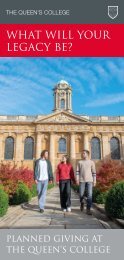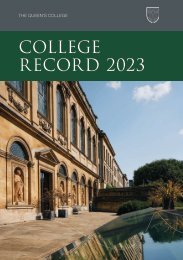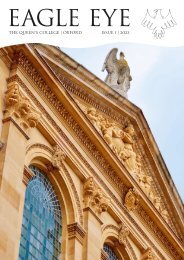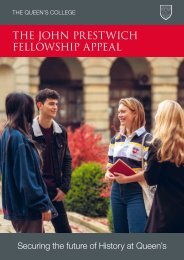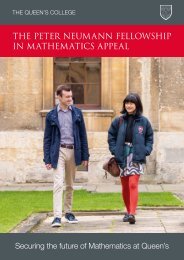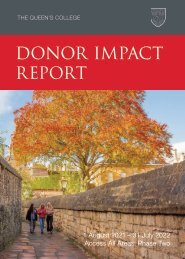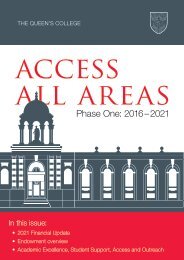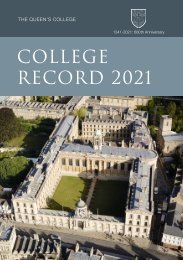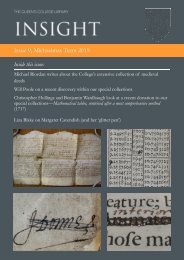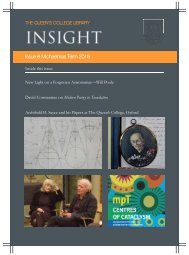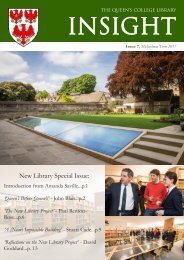The College Record 2022
Create successful ePaper yourself
Turn your PDF publications into a flip-book with our unique Google optimized e-Paper software.
Credit: John Cairns<br />
<strong>The</strong> Sedleian Professors of Natural Philosophy<br />
and Queen’s<br />
Dr Christopher Hollings, Clifford Norton Senior<br />
Research Fellow in the History of Mathematics<br />
<strong>The</strong> Sedleian Professorship of Natural Philosophy is one of<br />
Oxford’s oldest Chairs. It was founded in 1619 thanks to<br />
a bequest to the University from the barrister and Kentish<br />
landowner Sir William Sedley (c.1558–1618). Like the other professorships that were<br />
founded around this time (most notably, the Savilian Professorships of Geometry and<br />
Astronomy), the purpose of the Sedleian Chair was to provide centrally-organized<br />
lectures in an advanced subject that was not usually covered by college teaching:<br />
in this case, nature and the physical world. <strong>The</strong> early statutes required the professor<br />
to lecture specifically on Aristotle’s Physics.<br />
Articles<br />
Starting with the first Sedleian Professor, Edward Lapworth (1574–1636), the early<br />
incumbents of the Chair were all physicians, who devoted the greater part of their<br />
time to private medical practice, and have left little trace of their teaching activities.<br />
<strong>The</strong> notable exception is Thomas Willis (1621–1675). An important figure in the<br />
development of the understanding of the brain and nervous system, Willis ignored<br />
the requirement to teach Aristotle, and instead lectured on his own specialism.<br />
With the turn of the eighteenth century, the Sedleian Chair became more sinecure<br />
than actively occupied post. <strong>The</strong> first new professor of that century, James Fayrer<br />
(c.1655–1719), was even accused of having rigged his election. Some natural<br />
philosophy was taught by the Savilian Professors during this period, but the<br />
Sedleians are barely visible in University records. Among them was Joseph Browne<br />
(1700–1767), who was Provost of Queen’s from 1756. Like the other eighteenthcentury<br />
Sedleians, however, he had no obvious credentials in natural philosophy.<br />
<strong>The</strong> election of the astronomer Thomas Hornsby (1733–1810) to the Sedleian Chair<br />
in 1782 gave the post its first scientifically active occupant for almost a century.<br />
Hornsby was a pluralist who also held the Savilian Professorship of Astronomy,<br />
among other positions. He oversaw the establishment of the Radcliffe Observatory<br />
in the final decades of the century.<br />
During the years that sinecurists held the Sedleian Chair, the teaching of natural<br />
philosophy in Oxford began to take a different turn in the hands of others. James<br />
Bradley (1692–1762), Hornsby’s predecessor in the astronomy chair, introduced the<br />
teaching of material from Newton’s Principia Mathematica, and by the beginning of<br />
the nineteenth century, ‘natural philosophy’ had become a much more Newtonian<br />
than Aristotelian subject, concerning the mathematical study of the physical universe.<br />
When Hornsby died in 1810, the duties set out for his successor were to lecture ‘in<br />
<strong>College</strong> <strong>Record</strong> <strong>2022</strong> | <strong>The</strong> Queen’s <strong>College</strong> 97






